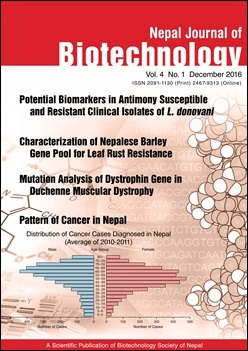Assessing the Role of Potential Biomarkers in Antimony Susceptible and Resistant Clinical Isolates of L. donovani from India
DOI:
https://doi.org/10.3126/njb.v4i1.16340Keywords:
ABC transporter, ornithine decarboxylase, γ- glutamylcysteine synthetase, antimony resistanceAbstract
Failure of antimonial drugs, the mainstay therapy for leishmaniasis has become an escalating problem in the treatment of Indian leishmaniasis. Using 14 clinical isolates from both visceral (VL) and post-kala-azar dermal leismaniasis (PKDL) patients, we have examined the role of ATP-binding cassette transporter (ABC transporter) gene, multidrug resistant protein A (MRPA) and two building blocks of the major thiol, trypanothione namely, ornithine decarboxylase gene (ODC) (a rate limiting enzyme in the polyamine biosynthesis) and γ-glutamylcysteine synthetase (γ-GCS) (a rate limiting enzyme in glutathione biosynthesis) in antimony resistance. Amplification of these three genes was observed in some but not all clinical isolates. Increased expression of the three RNAs as determined by real-time PCR was observed in all SAG-R clinical isolates. Significant increase in cysteine and glutathione levels was observed in the resistant isolates. Our studies report the underlying mechanism of antimony resistance in the clinical isolates.
Downloads
Downloads
Published
How to Cite
Issue
Section
License
Copyright Notice:
The manuscript submitted to NJB must be an original contribution, not previously published and should not be under consideration for publication elsewhere. When the manuscript is accepted for publication, the authors agree to automatically transfer the copyright of the article to the publisher. It should grant permission to any third party, in advance and in perpetuity, the right to use, reproduce or disseminate your article, according to the NJB copyright and license agreement.
Authors transfer copyright to the publisher as part of a journal publishing agreement but have the rights to: Share their article for Personal Use, Internal Institutional Use and Scholarly Sharing purposes, with the NJB applies the Creative Commons Attribution-NonCommercial CC BY-NC license to all the works we publish after Jun 2020 (Before it was CC BY-NC-ND). Under this license, authors agree to make articles legally available for reuse, without permission or fees, for virtually any non-commercial purpose. Anyone may remix, adapt, and build upon your work non-commercially, and although their new works must also acknowledge you and be non-commercial, they don’t have to license their derivative works on the same terms. More details on CC BY-NC refer to its Licence Deed and Legal Code.






